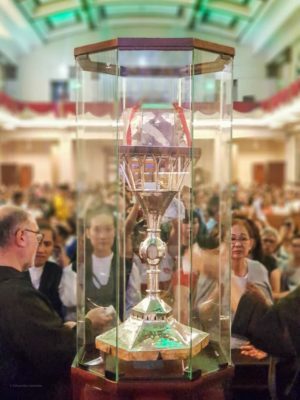
Photo from Pastoral Planning Board
THE Archdiocese of Cebu expects a “smooth welcome” for the heart relic of Saint Padre Pio as it arrives at the Mactan International Airport today, October 11.
According to Monsignor Joseph Tan, media liaison of the Archdiocese of Cebu, the San Padre Pio Contemplative Community of Cebu (SPPCCC) with the help of Monsignor Roger Fuentes worked hard to prepare for the event.
“Padre Pio influenced our lives so much,” said Richard Saing, President of SPPCCC who credits Padre Pio for his spiritual renewal.
The SPPCCC will oversee all preparations for the relic’s visit in Cebu from its arrival today, October 11 until its departure on October 14.
Tan said that huge crowds from all over Visayas are expected to gather to venerate the relic which will stay overnight at the Cebu Metropolitan Cathedral and then at the IEC Convention Center along Pope John Paul II Ave., Cebu City until its departure on Sunday.
As a security measure, Tan asked devotees to refrain from bringing backpacks and sharp objects.
“Prepare to pray for spiritual and physical healing. Come to confession also because confession will be available,” he added.
Devotees will be allowed to go near the relic, which is kept in a reliquary made of glass, but only for a limited time in consideration of the other people waiting in line for their turn.
Except on October 12, Friday, when an exclusive veneration will be held at the IEC Pavilion for the members of the clergy from 12 noon to 9 P.M., devotees are allowed to venerate 24/7 during the four-day visit of Padre Pio’s heart relic.
“All priests and religious are invited to be present on October 12 from Cebu and the Visayas,” said Tan.
The heart of Padre Pio arrived in the Philippines on October 9 and resided at the Manila Cathedral where devotees flocked to venerate the saint.
St. Pio of Pietrelcina is a revered saint most known for his stigmata, the bodily marks on the saint’s hands and feet corresponding to the wounds of Jesus Christ during the Crucifixion.
Padre Pio died on September 23, 1968 and was canonized by Pope John Paul II in 2002.
This year marks his 50th death anniversary and the centennial anniversary of the appearance of the stigmata.